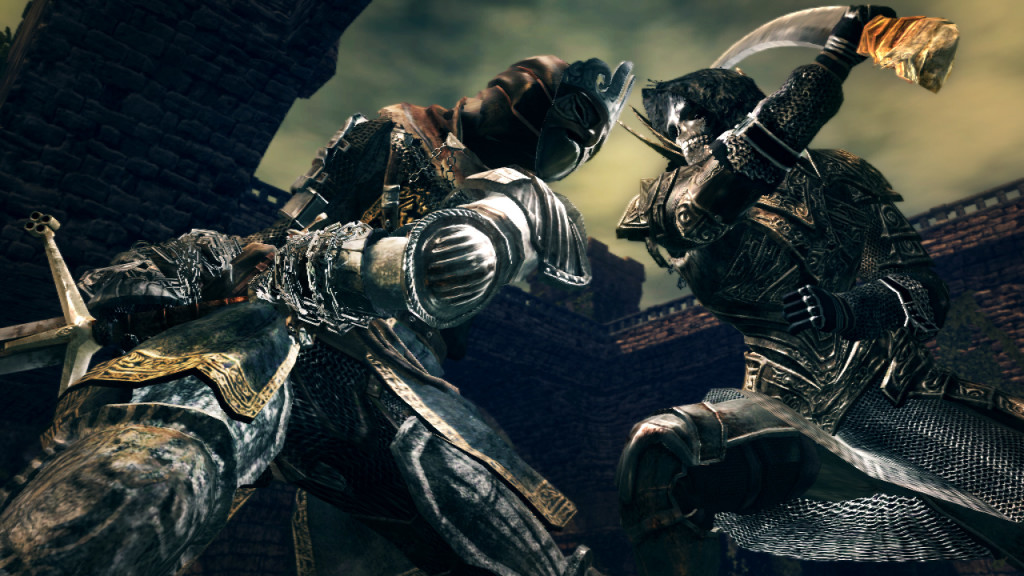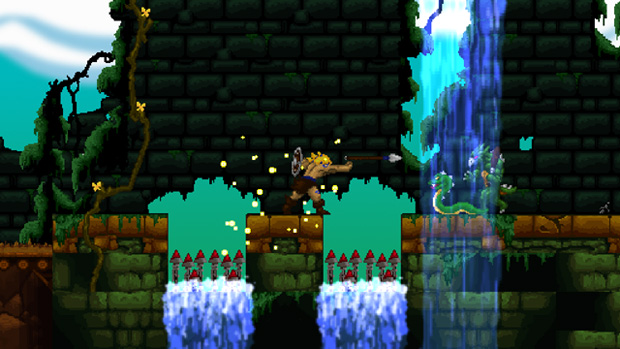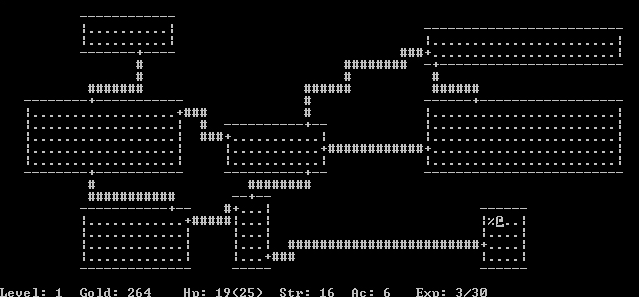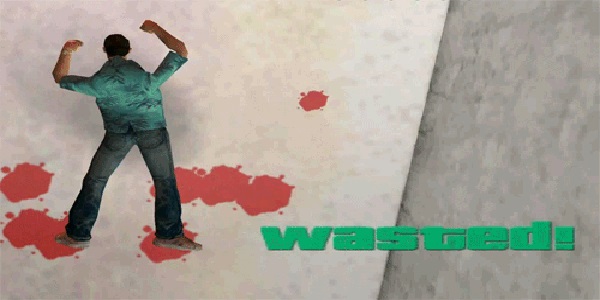Last updated on March 14, 2014
Let’s talk about death a little more.
Even though I walk through the valley of the shadow of death,
I fear no evil, for You are with me;
Your rod and Your staff, they comfort me.Psalm 23:4
Most single player video games take three primary approaches to the subject of “death”. One method uses the idea that most players understand innately: you die as a fail state, and then try again after that. Death represents a failure of your own making, the consequence for your mistakes. If you do not learn anything, you’ll die repeatedly until you understand exactly what caused that death. They present tasks, and you need to fulfill them like your life’s goal – even at the cost of death.
Games like Dark Souls and Volgarr the Viking represent the epitome of this first type, imbued with the spirit of coin-op arcade games smashed onto different frameworks and graphical engines. Dark Souls presents a combat system that, at best, feels entirely rudimentary – press button, swing thing, nothing fancy. This belies the risk/reward that each action will create in each situation. It buffers every action you perform, meaning that you must think about all your movements, rolls, dodges, and item usage in advance or die. And, as many noted throughout the Internet, You Will Die exemplifies the function of Dark Souls’ design.
Still, From Software provides so many solutions that death becomes an ephemeral concequence in the grand scheme. Sure, you lose all your Souls (i.e., currency), but think of it as trading money for experience. If you’re smart, you’ll spend it after farming it. Play it less like an action game and more like an RPG, and you’ll do fine. I’ll present one example off the top of my head: Bell Gargoyles gang up on you. Solution? Shoot the Hellkite’s tail off, get the weapon it drops, and go to town. No other weapon touches it in strength at this portion of the game. You still need to dodge and think, but there’s far more room for error. That’s true of most of Dark Souls – the more preparation, exploration, and experimentation, the more likely you will succeed with a greater variety of strategies to employ.
Volgarr the Viking, though set in a two dimensional “arcade-style” appearance, does something slightly different. It gives the player a set of tools available from the beginning of the game, useful for all situations. Then, you apply that moveset to every area of the game in different combinations and different ways. Mostly this involves memorizing the approach to a particular sequence, jump timing, how much damage an enemy takes, how to avoid damage yourself, and a host of tiny calculations. Like Dark Souls, you cannot rest for a moment (although thankfully there’s a pause button), and the game force you into its mold. Die, and you return back to the beginning of the stage or the mid-stage checkpoint. By doing this, Crazy Viking Studios allows us to appreciate their level design, vaguely memorizing it via feel and progress.
In fact, I’d say both of them work best due to our gaming culture’s current climate. They seem hard because everything else seems so easy by comparison. In reality, they require a different approach that hearkens back to video games past, and one I most certainly recommend. Death puts pressure on the player to succeed, even if the stakes feel relatively low.
To talk of the second approach, most usually call it a “roguelike”. Using it in our modern parlance, it often refers to the idea of “permadeath”, losing all of your progress and starting from the beginning. The original Rogue case you as a thief looking for treasure in a dungeon with a randomized layout. Each time, you would need to learn the tricks and traps, predicting and understanding what would happen. However, a mistake could lead to your death, and that death held permanent concequences. You cannot Continue, nor retain anything collected – you must start the game from the beginning.
While this sounds similar to the above, death puts a far greater pressure on the player to learn, perform, and do well. The game could end completely if not. Imagine playing Diablo’s Hardcore mode, for example. That’s not exactly a short game by any stretch (at least thirty hours), and if you die once the game ends. That’s some tension and pressure right there. Like in real life, death becomes the final arbiter. Unlike real life (in most cases), death results from your mistakes, and those mistakes mean the end of you. In other words, these games assume prior experience before diving into their depths. Once you learn everything, try conquering it without dying – the ultimate task. It’s no wonder this turned into a popular house rule among arcades (the “one credit clear, or 1cc) and home consoles (how many “no death” get posted to Youtube a day?).
The third approach, and one I vehemently dislike, is the one where death means absolutely nothing at all. I mean this in the design sense primarily. In Grand Theft Auto, for example, what’s the cost of death? A thousand dollars out of millions, maybe? How far back will any first person shooter’s campaign take you if you die? Back at the last liberally strewn checkpoint, of course! The game isn’t much interested in the player’s participation and knowledge. Rather, it wants to guide them through “an experience” rather than force them to learn a set of rules. Death has no meaning at all and by making it so difficult to die, while also reducing its consequences to the infinitesimal, they make it a non-event.
After playing at least a hundred of said games, they turned quite boring to me. Whatever caused them to do this (other than the obvious mass appeal), a movie isn’t a game, and a game isn’t a movie. Many of these games use death as an aesthetic choice. You’ll see it in the story, you’ll feel it in a dramatic arc that you cannot control, but you won’t ever experience it. Maybe vicariously, sure, but never directly. Video games just don’t function well in a traditional story mold, mostly because they just replicate the techniques of other mediums. Since you participate, you mess with the flow of the drama if you, for example, decide to mess around and glitch the game up. You can’t force an audience to feel, or do what you want them to do.
That’s why death became such a prevalent part of video games. Many would ascribe this to its clarity as a fail state – can’t argue with death, right? – but it also tells us something about ourselves. We don’t like dying. We want to avoid it. And we will do anything within the rules of the game to prevent it. Anyone who says otherwise, and plays “honorably” surely isn’t the kind of person who will survive a dying world or a clutch situation, that’s for sure. In a way, we turn into pragmatists of a sort.
Yet, on the positive end of the scale, that ability to try, try, and try again means we earn our way to life. We need to keep going, keep learning, keep moving, or keep dying. The game’s rules create pressure within a system of clear, easily explicated rules. Even if the creators obfuscate some of these rules (Hello, Dark Souls!), that doesn’t mean they cannot be found out. Death merely becomes a release of the tension, to once again reflect on our abilities and plan accordingly. In Christianity, our rules feel unerringly clear: follow Christ and His command. However reality looks, that does not change how we act, what we do, or who we are. We die and die again, but come back to life again and again, stronger in our journey through the baptism of fire.
When we no longer fear death, we can be free.
But when this perishable will have put on the imperishable, and this mortal will have put on immortality, then will come about the saying that is written, “Death is swallowed up in victory. O death, where is your victory? O death, where is your sting?” The sting of death is sin, and the power of sin is the law; but thanks be to God, who gives us the victory through our Lord Jesus Christ.
1 Corinthians 15:54-57




